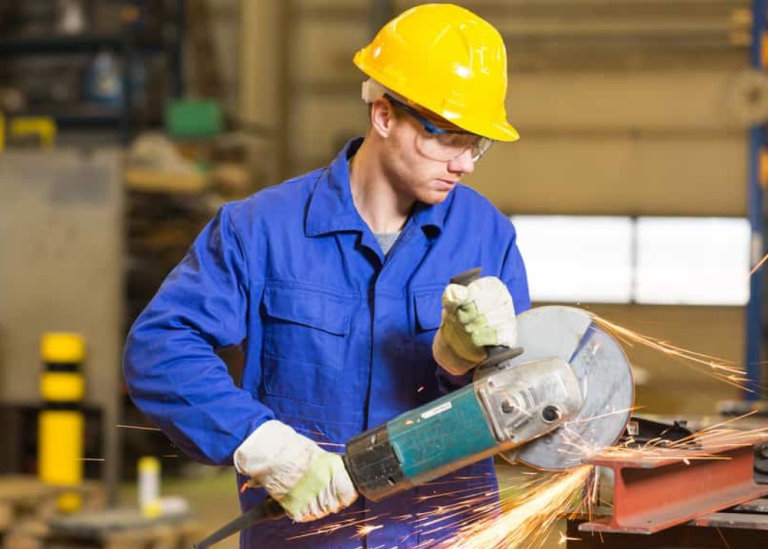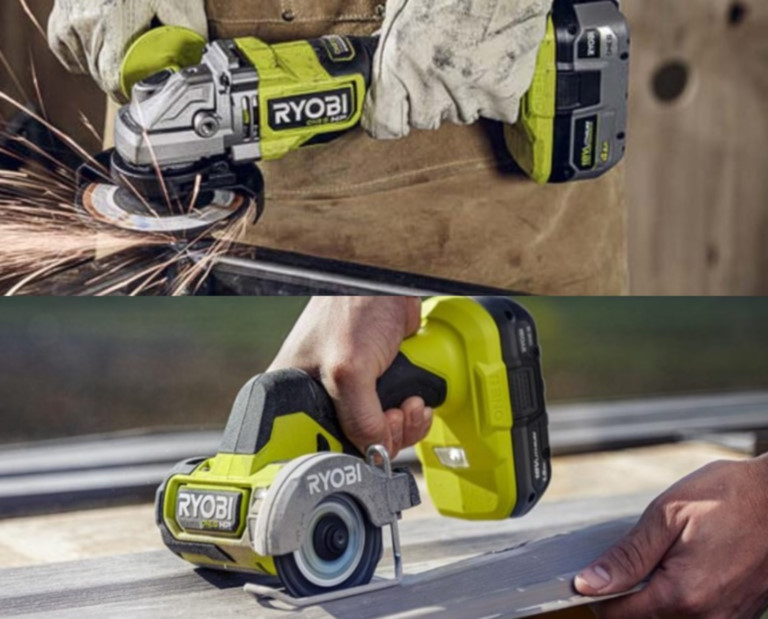Differentiating an angle grinder vs cut-off tool can be difficult at times as both of them are compact machines for cutting and sharpening metal. If you’re wondering which one of those tools would be best for your specific job, this article, with a detailed comparison, can assist your decision.
Contents
What Is An Angle Grinder Used For?
Angle grinders, also known as side grinders, are handheld power tools that can be utilized for a variety of tasks. In comparison to a cutting power tool, an angle grinder is equipped with a significantly bigger grinding blade, which makes them suitable for heavy-duty tasks.
They are useful tools to have no matter what kind of work and materials you undertake, like plastic, wood, mortar, and metal, to name a few.
An angle grinder can perform any tasks that rotary tools can. Its possible usage includes buffing an automobile’s body, completing carpentry projects, removing bothersome nails, cutting welding beads, removing rust, cutting welding beads, and grinding mortar, etc.

What Is A Cut-Off Tool Used For?
Cut-off tools are compact and portable with a perpendicularly mounted wheel on their shaft. They use motors that are under 1 horsepower, thus they aren’t meant to cut through tough metal slabs. Their common application is operating on small welding beads and thin metal sheets which need to be chopped off.
These tools are available in both air and electric versions. The pneumatic versions are more powerful and are typically utilized to remove hose clamps, sheet metal, mufflers, and bolts in automotive tasks. By contrast, electric cut-off tools are bigger but less powerful, typically utilized for light metalwork such as cutting conduits and sheet metal.

Angle Grinder & Cut Off Tool: In-Depth Comparison
Similarities
Despite different alignments, the components of these power tools are similar, including a cutting wheel, a motor, a driveshaft, and a handle.
They are also available in 3 kinds of energy systems: pneumatic, corded, and cordless tools.
Differences
Nevertheless, there are vast structural and functional differences that exist between an angle grinder and a cut-off tool.
| Criterion | Angle grinder | Cut-off tool |
| Use | Cutting, grinding, sharpening, polishing, removing rust | Cutting |
| Operation | Need more space to work | Can work in narrow spaces |
| Dexterity | Two-hand operation | One-hand operation |
| Wheel placement | Make an angle | Perpendicular to its driveshaft |
| Performance | Many types of materials | Thin materials |
| Safety features | Blade guard to prevent injuries | Weaker |
| Price | Higher | Cheaper |
Uses
You must identify why you require the power tool and what type of task you perform on a regular basis. Cutting metals, wood, and plastics can be done using cut-off tools, but angle grinders have much wider applications.
The latter can be used to sharpen lawnmower discs, polish other power tools, and remove rust from metals. Angle grinders are extremely versatile tools that may be used on a wide range of materials, consisting of porcelain or ceramic tiles, metal, concrete, and bricks.
Operation
Another difference between an angle grinder & a cut-off tool is their operation. The former is bigger and heavier, requiring more space to work, but the latter may fit into narrow spaces with ease.
Dexterity
You can use one hand to operate a cut-off tool due to its lightness. On the contrary, there are 2 handles on an angle grinder and it typically requires a two-hand operation.
Wheel placement
Also, the wheels of these tools are positioned differently in respect to the driveshaft. While the disc of cut-off tools is perpendicular to its driveshaft, that of angle grinders is angled.
Performance & Cutting materials
Cut-off tools’ motor can reach about 1 horsepower, whereas angle grinders use motors ranging between 3 and 7 horsepower. Hence, grinders are considerably larger and more powerful, which allows their capability to operate on a variety of surfaces.
This makes the former more ideal for tight areas where a larger tool finds hard to reach. Plus, they’re best suitable for cutting thin metals like sheet metal and car frames.
The latter, thanks to their diverse capability, can be utilized on various surfaces once swapping their discs. You can use them to directly remove corrosion from your shovel, sharpen lawnmowers’ and other tools’ blades.

Safety features
There are blade guards on the grinders protecting your hands from damage. The cutting tool, although equipped with no guards, will be hard to cause risk to users as its motor is weaker and less noise-polluted. So, there is still no clear conclusion on which tool is the safer option.

Price
Before purchasing these tools, figure out the limit of your budget and what you want to get out of it.
Generally, a cutting tool is less expensive than a grinder since it has few applications, requires less power, and only works on a limited number of materials. If you are a novice or a hobbyist, the former can be an acceptable alternative based on its cost-benefit analysis.
On the other hand, an angle grinder is quite costly since it is more powerful and more adaptable. It combines 5 separate tools into one. Therefore, you should consider if you’re willing to sacrifice money for stamina, adaptability, and durability.
The discs for both tools are fairly reasonable and around the same price. As a result, the discs are not a deciding element when it comes to expense.
Safety Tips When Using Angle Grinders & Cut Off Tools

Power tools are responsible for tens of thousands of emergency visits each year, so working with them is very risky. To avoid or lessen the risk, you should strictly adhere to the safety procedures which are comparably and equally vital whether you are operating a grinder or a cut-off tool. Below are some recommendations:
- Always wear safety gear like aprons and gloves.
- Must wear eye goggles for eye protection from sparks.
- Wear a nose mark to protect your lungs against dust-induced interstitial lung disease.
- Wear noise-canceling headphones for ear protection from long-term exposure to loud sounds.
- After using the tools, ensure to unplug them or switch off their power source.
- In the presence of children, never leave them along with your power tools.
- Before using your tools, ensure to read and follow the owner’s manual carefully.
FAQs (Frequently Asked Questions)
1. Can you use an angle grinder as a cut-off tool?
The answer is YES. An angle grinder is more versatile & powerful and can also be utilized for cutting tasks. However, there are some cautions that you need to pay attention to when using it instead of a cut-off tool.
First, as it is hefty and requires 2 hands to operate, it is not designed to work in confined locations like the cutting tools.
Second, a grinder’s disc and merely cutting tool’s one should not be used interchangeably. Only use the blade specially designed for the angle grinder, otherwise, it can cause the machine’s motor to fail and potentially result in serious harm.
See more: Angle grinder vs Circular Saw?
2. Can you use an angle grinder as a sander?
When attached to sanding accessories (also known as flap disks), an angle grinder can become a sander. These discs come in a variety of sizes and thicknesses, so you can choose which one based on your requirements. Then, you can utilize the disc to smooth and polish surfaces after attaching it to your grinder.
3. Can you use a cut-off tool on wood?
Wood is among materials that a cut-off tool can operate on, besides metals and plastic.
4. Can angle grinders be used for cutting?
Cutting jobs are certainly among various applications of angle grinders. With the right blades, they can cut a wide range of materials, including wood, concrete, metal, masonry, etc.
So, What Tool Should You Use?
Our angle grinder vs cut-off tool comparison has shown similarities as well as differences between these two types of power tools.
Even though the ultimate choice depends on each project, a Dewalt, Milwaukee, Ryobi, or whatever angle grinder brands will still be the best choice in most cases due to its higher horsepower and versatility. However, you can opt for a merely cutting tool if your job site is hard to reach and the materials to be cut don’t require lots of power.
